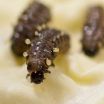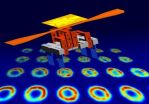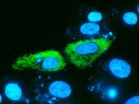(Press-News.org) This press release is available in German.
Max Planck scientists in Jena, Germany, have discovered an unusual regulation of enzymes that catalyze chain elongation in an important secondary metabolism, the terpenoid pathway. In the horseradish leaf beetle Phaedon cochleariae a single enzyme can trigger the production of two completely different substances depending on whether it is regulated by cobalt, manganese or magnesium ions: iridoids, which are defensive substances the larvae use to repel predators, or juvenile hormones, which control insect's development. Insects unlike plants do not have a large arsenal of the proteins called isoprenyl diphosphate synthases. Therefore they may have developed another efficient option to channel metabolites into the different directions of terpenoid metabolism by using metal ions for control. (PNAS, Early Edition, February 25, 2013, DOI:10.1073/pnas.1221489110)
Natural products: 40,000 terpenes
Apart from the primary metabolism which produces substances that ensure the survival of the cells, there are additional biosynthetic pathways in all organisms. Their products may be less important for a single cell, but they can nevertheless be essential for the whole organism. These pathways are summarized as secondary metabolism. One of them is the terpenoid pathway: with more than 40,000 different known structures it generates one of the largest classes of natural products. Terpenoid molecules have diverse functions and can act as components in molecular signaling pathways, as toxins, fragrances or hormones.
The basic unit of all terpenes is a simple molecule containing five carbon atoms that can be joined to chains of different length. There are monoterpenes (C10 units, 2 x C5), sesquiterpenes (C15, 3 x C5), and even polymers, such as natural rubber, which comprises several hundred C5 units. Special enzymes mediate chain elongation. These enzymes have attracted the curiosity of scientists at the Max Planck Institute for Chemical Ecology, Jena, and the Leibniz Institute for Plant Biochemistry in Halle. They studied mechanistic alternatives of how chain elongation is regulated.
Metal ions instead of specialized enzymes
Enzymes involved in chain elongation belong to the group of isoprenyl diphosphate synthases. Such an enzyme was isolated from larvae of the horseradish leaf beetle Phaedon cochleariae. It raised the interest of Antje Burse, project group leader in the Department of Bioorganic Chemistry at the Max Planck Institute for Chemical Ecology.
Experiments with larvae in which the enzyme encoding gene was silenced showed that the protein was involved in the formation of the C10 monoterpene chrysomelidial that larvae produce to defend themselves against predators. The larvae accumulate this monoterpene in special glands and release it as a defensive secretion when they are attacked by their enemies, such as ants.
However, surprising results emerged after comprehensive biochemical characterization of the enzyme. "After we had conducted an in vitro analysis of the protein, including measurements of product formation in the presence of different metal ions as co-factors, we were surprised to discover that only geranyl diphosphate (C10), a precursor for the defensive substance chrysomelidial, was produced after addition of cobalt and manganese ions. On the other hand, adding magnesium ions resulted in the formation of farnesyl diphosphate (C15), a potential precursor for juvenile hormones, which is 5 carbon atoms longer," says the scientist. All three metals were found in larval tissue, leading to the assumption that enzyme catalysis is directed by the different metal co-factors in the larvae, whichever is predominant in amount: Towards toxin or hormone − physiologically a major difference.
Sequence comparisons cannot replace a thorough biochemical analysis
How the different metal ions modify the product range of the enzyme is still unclear. It is very likely that the varying atomic radii of the metal ions involved in the catalysis effect changes in the spatial structure of the enzyme, which prevent or allow the admission of a third C5 unit and hence result in the production of C10 or C15 molecules.
"Our experiments provide two important findings," says Wilhelm Boland, director at the Max Planck Institute. "First, the directing influence of metal ions on the product formation of isoprenyl diphosphate synthases is a novel "control element" in the regulation of the terpene metabolism which should be included in future experimental settings. And secondly: The diversity of terpenoid molecules cannot be attributed solely to the broad substrate specificity of some enzymes in the last steps of the metabolic pathway, but is in fact already inherent in early biosynthetic steps." Nature continues to provide interesting answers to the question how organisms manage to produce tens of thousands of different secondary metabolites. [JWK/AO]
INFORMATION:
Original Publication:
Sindy Frick, Raimund Nagel, Axel Schmidt, René R. Bodemann, Peter Rahfeld, Gerhard Pauls, Wolfgang Brandt Jonathan Gershenzon, Wilhelm Boland, Antje Burse: Metal ions control product specificity of isoprenyl diphosphate synthases in the insect terpenoid pathway. Proceedings of the National Academy of Sciences USA, Early Edition, February 25, 2013, DOI:10.1073/pnas.1221489110
http://dx.doi.org/10.1073/pnas.1221489110
Further Information:
Dr. Antje Burse
49-3641-57-1265
aburse@ice.mpg.de
Picture Requests:
Angela Overmeyer M.A.
49-3641-57-2110
overmeyer@ice.mpg.de
or Download via www.ice.mpg.de/ext/735.html
Metal ions regulate terpenoid metabolism in insects
Controlled by metal ions, a prenyl synthase in leaf beetle larvae produces the precursors for chemical defenses or juvenile hormones
2013-02-28
ELSE PRESS RELEASES FROM THIS DATE:
Study led by NUS researchers proves the existence of 3 overstretched DNA structures
2013-02-28
A team of researchers led by Associate Professor Yan Jie from the Department of Physics at the National University of Singapore (NUS) Faculty of Science has identified three new distinct overstretched deoxyribonucleic acid (DNA) structures caused by mechanical stretching. This discovery provides a clear answer to a long-running debate among scientists over the nature of DNA overstretching.
Debate on Possible DNA Structural Transitions
Recent single-molecule studies revealed that mechanical stretching could induce transitions to elongated DNA structures. Three possible ...
Atoms with quantum memory
2013-02-28
This press release is available in German.
Ice cubes in a cocktail glass melt until an equilibrium state is reached in which the ice cubes are gone. After that, the geometric shape of the ice cubes is completely lost. The liquid does not contain any memory of their shape, the ordered ice crystal has turned into disordered water molecules. Ultra cold Bose-Einstein condensates behave differently; these highly ordered clouds of ultra cold particles also approach a disordered equilibrium state, but they retain some "memory" about their initial state for a remarkably long ...
Mayo Clinic finds steroids may shorten hospital stay for pneumonia patients
2013-02-28
ROCHESTER, Minn. — Patients with pneumonia may spend fewer days in the hospital if they are given steroids along with antibiotics and supportive care. That's the finding of a Mayo Clinic analysis of eight randomized-controlled clinical trials involving more than 1,100 patients. The results appear in the March issue of the Journal of Hospital Medicine.
"Given that the average hospital stay for community-acquired pneumonia can range from nine to 23 days, the prospect of speeding recovery, even by a day or two, is helpful," says co-author M. Rizwan Sohail, M.D., a Mayo infectious ...
'Crazy-busy' Canadians under pressure on the job
2013-02-28
Having more control in the workplace can have negative consequences for individuals but it depends on the form of job control, according to new research out of the University of Toronto.
Sociologist Scott Schieman measured a range of work conditions using data from a national survey of 6,004 Canadian workers. To measure levels of job pressure, he asked study participants questions such as: "How often do you feel overwhelmed by how much you had to do at work?" "How often do you have to work on too many tasks at the same time?" and "How often do the demands of your job ...
Discoveries suggest icy cosmic start for amino acids and DNA ingredients
2013-02-28
Using new technology at the telescope and in laboratories, researchers have discovered an important pair of prebiotic molecules in interstellar space. The discoveries indicate that some basic chemicals that are key steps on the way to life may have formed on dusty ice grains floating between the stars.
The scientists used the National Science Foundation's Green Bank Telescope (GBT) in West Virginia to study a giant cloud of gas some 25,000 light-years from Earth, near the center of our Milky Way Galaxy. The chemicals they found in that cloud include a molecule thought ...
Researchers show that lipid nanoparticles are ideal for delivering genes and drugs
2013-02-28
This press release is available in Spanish.
At the Faculty of Pharmacy of the Basque Public University (UPV/EHU) the Pharmacokinetics, Nanotechnology and Gene Therapy research team is using nanotechnology to develop new formulations that can be applied to drugs and gene therapy.Specifically, they are using nanoparticles todesignsystems for delivering genes and drugs; this helps to get the genes and drugs to the point of action so that they can produce the desired effect.
The research team has shown that lipid nanoparticles, which they have been working on for several ...
Creating your own animated 3D characters and scenes for the web
2013-02-28
It could be a grotto. Light is glowing up from below and gives the moving waves a glance of an opal under the sunlight. "This computer graphic was written with our new description language by a schoolboy in not more than two hours after a briefly reading of the instructions", explains Felix Klein, doctoral candidate at the chair of Computer Graphics at Saarland University. As Klein is moving three slide switches with the mouse which are placed under the wave graphic on the display, the water is transforming. Now, the waves are spreading circularly from the center point, ...
Mutation altering stability of surface molecule in acid enables H5N1 infection of mammals
2013-02-28
A single mutation in the H5N1 avian influenza virus that affects the pH at which the hemagglutinin surface protein is activated simultaneously reduces its capacity to infect ducks and enhances its capacity to grow in mice according to research published ahead of print today in the Journal of Virology.
"Knowing the factors and markers that govern the efficient growth of a virus in one host species, tissue, or cell culture versus another is of fundamental importance in viral infectious disease," says Charles J. Russell of St. Jude Children's Research Hospital, Memphis, ...
Cell movement explained by molecular recycling
2013-02-28
VIDEO:
This shows fibroblast cells using integrins to migrate through tissue.
Click here for more information.
Scientists at The University of Manchester have identified the method by which cells control the recycling of molecules, a process that is essential for them to move. The discovery provides researchers with a better understanding of how our bodies heal wounds.
Working under Professor Martin Humphries, the Dean of the Faculty of Life Sciences, Dr Mark Morgan and ...
Trackable drug-filled nanoparticles -- a potential weapon against cancer
2013-02-28
Tiny particles filled with a drug could be a new tool for treating cancer in the future. A new study published by Swedish scientists in Particle & Particle Systems Characterization shows how such nanoparticles can be combined to secure the effective delivery of cancer drugs to tumour cells – and how they can be given properties to make them visible in MR scanners and thus rendered trackable.
The team, which consisted of scientists from Karolinska Institutet (KI) and the Royal Institute of Technology (KTH) in Stockholm, and from Chalmers University of Technology in Gothenburg, ...
LAST 30 PRESS RELEASES:
Heart-brain connection: international study reveals the role of the vagus nerve in keeping the heart young
Researchers identify Rb1 as a predictive biomarker for a new therapeutic strategy in some breast cancers
Survey reveals ethical gaps slowing AI adoption in pediatric surgery
Stimulant ADHD medications work differently than thought
AI overestimates how smart people are, according to HSE economists
HSE researchers create genome-wide map of quadruplexes
Scientists boost cell "powerhouses" to burn more calories
Automatic label checking: The missing step in making reliable medical AI
Low daily alcohol intake linked to 50% heightened mouth cancer risk in India
American Meteorological Society announces Rick Spinrad as 2026 President-Elect
Biomass-based carbon capture spotlighted in newly released global climate webinar recording
Illuminating invisible nano pollutants: advanced bioimaging tracks the full journey of emerging nanoscale contaminants in living systems
How does age affect recovery from spinal cord injury?
Novel AI tool offers prognosis for patients with head and neck cancer
Fathers’ microplastic exposure tied to their children’s metabolic problems
Research validates laboratory model for studying high-grade serous ovarian cancer
SIR 2026 delivers transformative breakthroughs in minimally invasive medicine to improve patient care
Stem Cell Reports most downloaded papers of 2025 highlight the breadth and impact of stem cell research
Oxford-led study estimates NHS spends around 3% of its primary and secondary care budget on the health impacts of heat and cold in England
A researcher’s long quest leads to a smart composite breakthrough
Urban wild bees act as “microbial sensors” of city health.
New study finds where you live affects recovery after a hip fracture
Forecasting the impact of fully automated vehicle adoption on US road traffic injuries
Alcohol-related hospitalizations from 2016 to 2022
Semaglutide and hospitalizations in patients with obesity and established cardiovascular disease
Researchers ‘listen in’ to embryo-mother interactions during implantation using a culture system replicating the womb lining
How changing your diet could help save the world
How to make AI truly scalable and reliable for real-time traffic assignment?
Beyond fragmented markets: A new framework for efficient and stable ride-pooling
Can shape priors make road perception more reliable for autonomous driving?
[Press-News.org] Metal ions regulate terpenoid metabolism in insectsControlled by metal ions, a prenyl synthase in leaf beetle larvae produces the precursors for chemical defenses or juvenile hormones




